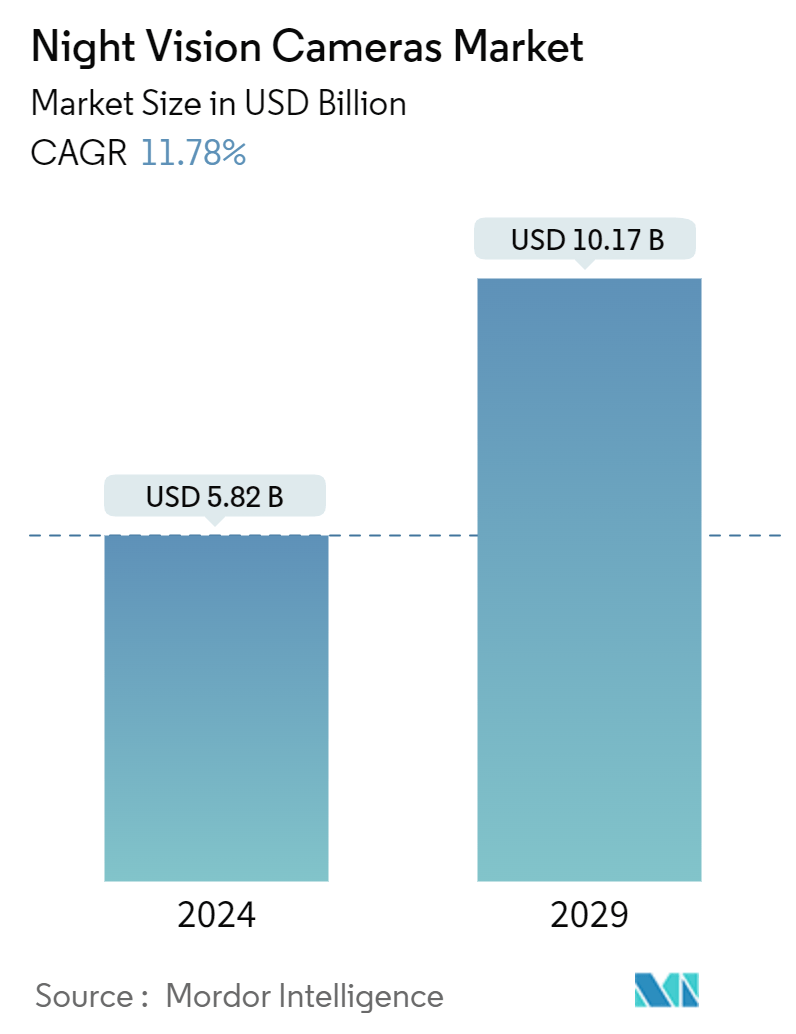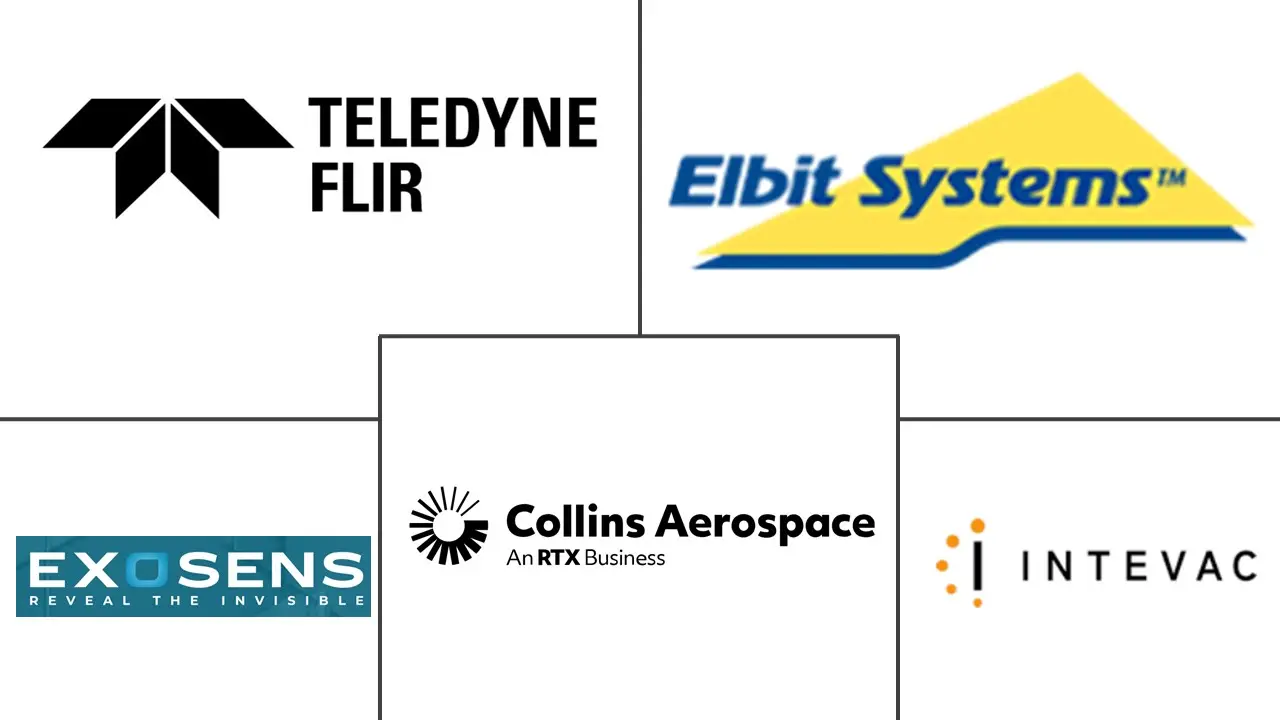Market Size of Night Vision Cameras Industry

| Study Period | 2019 - 2029 |
| Market Size (2024) | USD 5.82 Billion |
| Market Size (2029) | USD 10.17 Billion |
| CAGR (2024 - 2029) | 11.78 % |
| Fastest Growing Market | Asia Pacific |
| Largest Market | North America |
Major Players
*Disclaimer: Major Players sorted in no particular order |
Night Vision Camera Market Analysis
The Night Vision Cameras Market size is estimated at USD 5.82 billion in 2024, and is expected to reach USD 10.17 billion by 2029, growing at a CAGR of 11.78% during the forecast period (2024-2029).
Night vision cameras are essential for enhancing the efficiency of a video surveillance system in low-light situations. The key characteristic that combines all these cameras is the inclusion of IR illumination, which is crucial for conducting video surveillance during nighttime.
Night vision cameras safeguard valuable assets by capturing video evidence of vandalism, theft, and unauthorized activities in low-light conditions. Most standard security systems or cameras often fail to fulfill this task. Advanced night vision security cameras enable an impressive array of features to make after-hours video surveillance easy, efficient, and accurate. They are one of the fastest-growing security systems in the global market. As a result, these cameras are being preferred across various industries and, in some cases, by several individuals for residential, public infrastructure, and industrial applications.
Advanced night vision security cameras offer a wide range of functions to simplify, streamline, and enhance video surveillance during nighttime hours. They have become one of the most rapidly expanding security solutions worldwide. Consequently, these cameras are gaining popularity in different sectors and, in certain instances, among numerous individuals for home, public facility, and industrial uses. Moreover, governments are prioritizing night vision features for their intelligent camera setups.
Night vision cameras are increasingly used for automobiles in the civilian market. In bad weather conditions or at night, automotive night vision systems can increase a driver's perception and viewing distance. Typically, they capture data via infrared or thermal imaging, occasionally paired with active illumination techniques, and then show it to the driver. Night vision has also been used in aircraft and helicopters, low-light hunting, and night shooting competitions.
These night-vision systems are subjected to challenging battlefield circumstances and extensive military use. The expense of replacing and maintaining a night vision gadget is prohibitively expensive. Refurbishment, repair, or upgrade is a low-cost alternative solution. The increased prices of near-vision device systems relate to practical and durable hardware. As an image tube can cost millions of dollars to develop, build, and install, the equipment contains a more significant capital expenditure necessary to invest in it. Due to the sensitivity of the cooled infrared detector system, cooled thermal imaging cameras give the best image quality and the most significant variation in ambient temperature. Still, the cooling systems have a limited lifetime.
The night vision cameras market was impacted significantly due to the outbreak of COVID-19 as the supply chain disruption due to travel restrictions and labor shortage issues influenced manufacturers' production capabilities. However, the upliftment of COVID-19-led restrictions eased the supply chain issues, helping the manufacturers of night vision cameras expand their production capabilities.
Apart from the pandemic influencing the demand and supply chain, it also led to the emergence of new use cases of night vision cameras, which is anticipated to support the market's growth post-COVID-19. For instance, during the pandemic, the South Diego Chula Vista Police Department announced an investment of over USD 11,000 to acquire two drones equipped with night vision cameras to mitigate the risk to the officers in these areas. The department mentioned that it aimed to watch over people living on the streets with these drones amid the outbreak.
Night Vision Camera Industry Segmentation
Night vision cameras are used to intensify human sight under very low light conditions. The market is segmented on the basis of technology and safety and security measures across different industries, such as manufacturing, services, transportation, military and defense, and automobile.
The night vision cameras market is segmented by type (wired night vision cameras, wireless night vision cameras), end user (military and defense, industrial, public and residential infrastructure, transportation, and research), and geography (North America, Europe, Asia-Pacific, and Rest of the World). The report offers market sizes and forecasts in terms of value (USD) for all the above segments.
| By Type | |
| Wired Night Vision Cameras | |
| Wireless Night Vision Cameras |
| By End User | |
| Military and Defense | |
| Industrial | |
| Public and Residential Infrastructure | |
| Transportation | |
| Research | |
| Other End Users |
| By Geography*** | |
| North America | |
| Europe | |
| Asia | |
| Australia and New Zealand | |
| Latin America | |
| Middle East and Africa |
Night Vision Cameras Market Size Summary
The night vision cameras market is poised for substantial growth, driven by their critical role in enhancing video surveillance capabilities in low-light conditions. These cameras, equipped with infrared illumination, are increasingly preferred across various sectors, including residential, public infrastructure, and industrial applications, due to their ability to capture video evidence of unauthorized activities. The demand for advanced night vision security cameras is rising as they offer a comprehensive range of features that simplify and improve nighttime surveillance. The market is experiencing rapid expansion globally, with significant interest from governments prioritizing night vision technologies for intelligent camera systems. Additionally, the automotive sector is witnessing increased adoption of night vision systems to enhance driver perception in low-light and adverse weather conditions.
The military and defense sectors are major contributors to the night vision cameras market, driven by the need for enhanced surveillance and combat capabilities. The ongoing geopolitical tensions and the need for improved security measures have led to increased investments in night vision technologies by countries such as China, India, Japan, and South Korea. The market is characterized by a mix of global players and SMEs, with companies like Intevac Inc., Photonis (Exosens), Elbit Systems Ltd, Rockwell Collins Inc., and FLIR Systems Inc. leading the charge. Strategic partnerships and acquisitions are common as companies seek to enhance their product offerings and maintain a competitive edge. The Asia-Pacific region is expected to see significant growth due to rising defense spending and technological advancements, further propelling the market's expansion.
Night Vision Cameras Market Size - Table of Contents
-
1. MARKET DYNAMICS
-
1.1 Market Overview
-
1.2 Industry Value Chain Analysis
-
1.3 Industry Attractiveness - Porter's Five Forces Analysis
-
1.3.1 Threat of New Entrants
-
1.3.2 Bargaining Power of Buyers/Consumers
-
1.3.3 Bargaining Power of Suppliers
-
1.3.4 Threat of Substitute Products
-
1.3.5 Intensity of Competitive Rivalry
-
-
-
2. MARKET SEGMENTATION
-
2.1 By Type
-
2.1.1 Wired Night Vision Cameras
-
2.1.2 Wireless Night Vision Cameras
-
-
2.2 By End User
-
2.2.1 Military and Defense
-
2.2.2 Industrial
-
2.2.3 Public and Residential Infrastructure
-
2.2.4 Transportation
-
2.2.5 Research
-
2.2.6 Other End Users
-
-
2.3 By Geography***
-
2.3.1 North America
-
2.3.2 Europe
-
2.3.3 Asia
-
2.3.4 Australia and New Zealand
-
2.3.5 Latin America
-
2.3.6 Middle East and Africa
-
-
Night Vision Cameras Market Size FAQs
How big is the Night Vision Cameras Market?
The Night Vision Cameras Market size is expected to reach USD 5.82 billion in 2024 and grow at a CAGR of 11.78% to reach USD 10.17 billion by 2029.
What is the current Night Vision Cameras Market size?
In 2024, the Night Vision Cameras Market size is expected to reach USD 5.82 billion.

